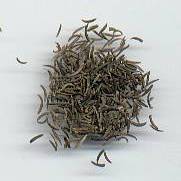Black Cumin, in India also called Kashmiri cumin, is not much known outside Iran, Tajikistan, Afghanistan, Pakistan and the western part of Northern India (Kashmir, Punjab). It is preferred to ordinary (white) cumin for some Northern Indian meat dishes (korma [कोरमा]) and rice dishes (biryani [बिरयानी]); if unavailable, toasted white cumin is an acceptable alternative.
In speaking about Northern Indian cookery, often the Moghul cooking is meant exclusively, although this does injustice to other distinct Northern Indian cuisines (Kashmir, Punjab, Bengal). Inside and outside India, Moghul food is particularly successful in restaurants.
Moghul cuisine is much affected by Islâm and by the cooking style of the imperial court in Delhi (later Agra), the great influence of which was difficult to ignore even for Hindu rulers. The Moghuls, Emperors of Northern India in the 16.th and 17.th century, gave name to this new cooking style which combines elements from Iranian and Arabic-style Central Asian cuisine with native Indian cooking traditions. Beside a bias towards non-vegetarian food, Moghul cuisine is characterized by little pungency, large amounts of aromatic spices and dried fruits, and rich and full-flavoured gravies.
Sauces and gravies are usually based on onion (see there for details), garlic and fresh ginger, as in the rest of India. Their intensive fragrance is due to cinnamon, cloves, black and even more often green cardamom; these tough spices are fried in hot butter fat (ghi [घी]) at great heat until they darken and begin to release their fragrance. Then, heat is reduced, and one adds onion, garlic and ginger (and possibly some Indian bay leaves) and fries until the spices turn light brown. After the mixture has been quenched with yoghurt and several more spices (black cumin, fennel, paprika) have been added, meat or vegetables are cooked in the gravy until tender. The sauce may be thickened with some ground poppy or grated almonds.
Food prepared in this way,
Moghul recipes are very popular in Indian restaurants in the West, e. g.
rogan josh [रोग़न जोश, less correctly written रोगन जोश],
mutton braised in a creamy and spicy yoghurt sauce with much red paprika and fragrant garlic,
which is actually a Moghul-style adoption of a much hotter,
chile-laden epinymous local Kashmiri recipe.
Other Moghul favourites include
kabab husaini [कबोब हुसैनी]
(minced mutton stuffed with a subtly flavoured mixture of raisins and almonds)
and biryani or biriyani [बिरयानी],
a complex rice dish (see Indian bay-leaf)
often flavoured with saffron.



